I just got an A7R IV along with a Tamron 17-28 and Sony 35/1.8 + 20/1.8 G, for some of the same reasons you're mulling over (C-AF, lens choices & DoF control w/wides, astro)... I always wanted that Voigtlander 10.5/0.95 but the weight and MF kept my away; the Sony is lighter, better corrected for astro, and sharper wide open so the temptation was too much! My intention is precisely to replace my PL8-18 & 17/1.2 but I'm still experimenting with the Sony gear and still in lockdown so we'll see... Haven't sold the former yet, gotta satisfy my own curiosity 1st.

If there's any comparisons or specific info you're looking for feel free to ask. I don't intend to sell any of my other M4/3 gear either (smaller primes, bodies, teles, etc.; all on my profile gear list), tho I might give away the PL25 II to a family member, specially if I get the Samyang 45/1.8... The PL25 II could actually be an interesting choice that address #1-3 for you without the bulk of something like the 17/1.2 btw, that's half the reason I got it even tho I prefer the latter's FL. I'd borrowed the first version and knew what I was getting, there's more optical compromises w/it than with something like the 17/1.2 but I like how it tows that line.
Many of the M4/3 teles I've got and love (be it zooms or primes) would be hard to replace with anything even close to the same size in any other system/format, and I often use them on a GX850 alongside my E-M5 II/III so mixing systems didn't seem as unnatural or as much of a headache to me as it might seem to others, I guess. Right now what I think I'll miss most when I don't bring the E-M5 III along will be the IBIS for video and/or dragging the shutter out a lot with a wide lens. 'Course the 61MP A7R is like having HR mode handheld...
There's some workarounds for manual focus bracketing w/Sony but it's a kludge compared to Oly's implementation. I'm gonna experiment with using their BT remote to do so at some point... Nothing like Live Composite w/Sony either.
I was really happy with the PL8-18 FWIW (I even like it's build slightly better than the Oly Pro's), and with the 17/1.2 too tho that one is a bit more of a size concession than what I would've liked... But it did keep me from jumping formats for a while and a lot of the Sony lenses I've been looking at weren't even out 2+ years ago. The Sony 35/1.8 being smaller was part of it's appeal tbh. I'm eyeing the Samyang 75/1.8 too, which is about the size of the Oly 75/1.8 but lighter... Again tho, I'm more likely to be using that Oly 75mm and the Pana 42.5/1.7 (and the 35-100, 100-300 II, etc).
Sony and Oly menus both suck IMO, both offer a great degree of customization, neither is as intuitive as say Panasonic (who also happens to have the better touch implementation, tho high end Sony/Oly bodies now have joysticks); those things don't really bother me once I have a camera dialed in to work how I like tho. I did take long look at Nikon because I like that Z 14-30mm f4, but their 20-35-85 primes are all larger and a little pricier without much of any optical benefit (that I could see based on reviews from DPR, Cameralabs, etc.), and there's not much 3rd party glass yet.
I'm of no use when it comes to opining on those super zooms since I never liked them a ton, but I think they're always a compromise regardless of format and if the point is to go light I'd probably just grab a Pana 14-140 II. I think the older M4/3 10x zooms are somewhere underrated these days (I've actually used that Pana since I bought it as a gift for my mother btw), but I dunno how that Tamron would really compare with the similarly sized Oly. I'd listen to other's opinion of the Oly, heh. I just got used to having a small tele on a 2nd body since I like shooting UWA/wide so much with my main. I don't think the Tamron squeezes out as much from the format as the Oly, even if has the DoF control advantage at times and isn't any larger.
That Oly offer for a free f1.2 prime is pretty killer, they must really wanna clear out old E-M1 II stock...

I don't think a lot of the older Sony options are as well sealed as some of the more recent ones btw (they claimed weather sealing on lenses that didn't even have a rear gasket /facepalm), but I'm not about to purposely put that to the test heh. I never had any complaints about that with my M4/3 gear, tho I mostly had internal zooming lenses or primes which are easier to seal. Oly seems to go to great lengths on this with some of their extending zooms (based on Imaging Resource articles at least).
No wrong choices here really, it's more about preference and how you see things working for you. I don't imagine there's a ton of people shooting a tiny 16MP body alongside a 61MP one (even amongst the few hobbyists that'll carry two at times), but it works for me and I enjoy it. There's numerous reasons some people will mix systems/formats and those that do often seem less cantankerous about it all, specially after the honeymoon period with either is over.

We'll probably never have a wider variety of choices in this market than we do today, so enjoy it while it lasts. Imma stop rambling now...



